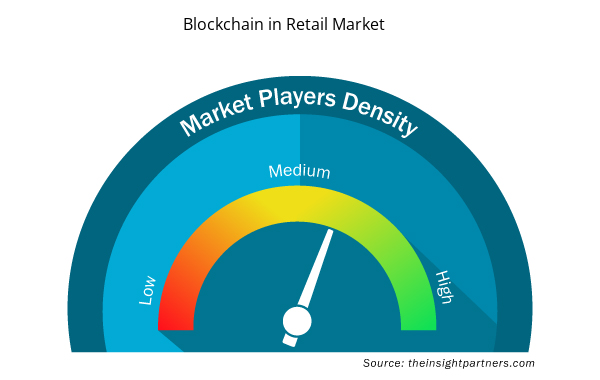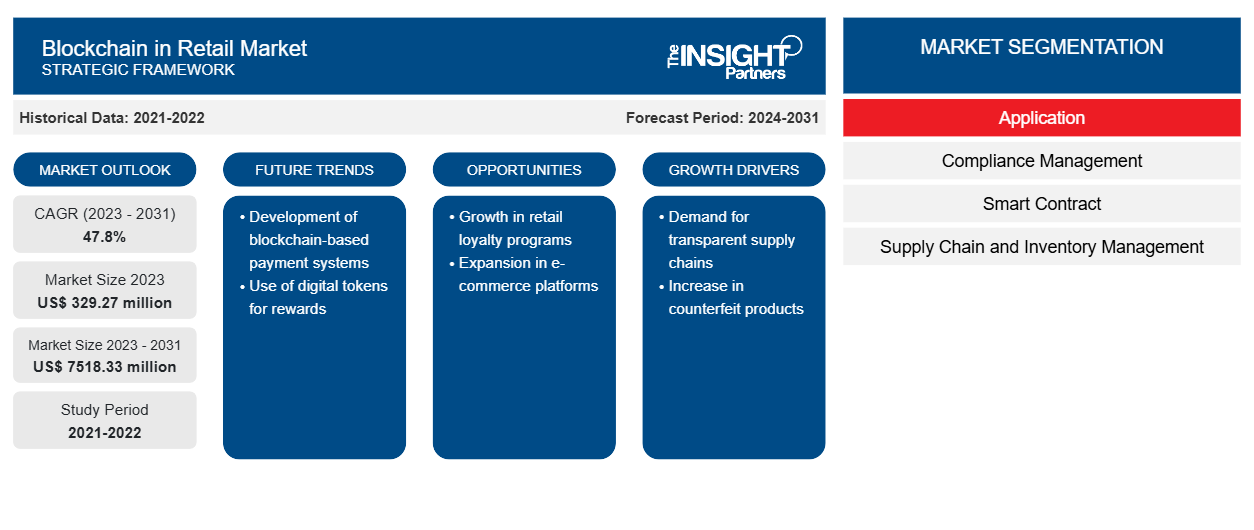零售业区块链市场规模预计将从 2023 年的 3.2927 亿美元增长至 2031 年的 75.1833 亿美元;预计从 2023 年到 2031 年,该市场的复合年增长率将达到 47.8%。区块链是一种在网络上共享的不可变账本或数字记录,通常被视为优化服务和流程的工具。无论是追踪资产,还是更常见的记录交易,区块链都因其提供的巨大可能性而继续受到青睐,尤其是在金融领域。
区块链在零售市场分析
零售市场预测中的区块链是根据各种二手和一手研究结果(例如主要公司出版物、协会数据和数据库)估算的。区块链为商店提供了一种更好的方法来保护、组织和共享数据。商家、消费者和制造商之间的透明度越高,信心就越大,灵活性就越高,服务选项的选择也越多。在零售中使用区块链可以记录产品的每一次移动,更好的是,批发商和零售商可以跟踪这些移动。总体而言,系统管理高效而简单,分类账保存在网络上,所有相关方都可以轻松访问。零售业的绝对速度和行业的快速扩张,以及客户需求不断增长的不断变化的格局,使区块链成为理想的选择。该解决方案解决了广泛的行业问题,包括安全和假冒问题、数据管理障碍以及运营费用的显着降低。
零售业中的区块链
行业概览
- 区块链技术可以通过降低或消除合作伙伴之间的潜在摩擦来改善企业流程。智能合约可以帮助简化合同实施。一旦满足预定义的合同义务,合同条件就可以自动执行。
- 2019年,家乐福逐步将区块链技术引入到以下家乐福优质产品线:奥弗涅鸡肉、Cauralina番茄、Loué农场鸡蛋、Rocamadour AOC奶酪、Gillot鲜牛奶、挪威三文鱼和圣诞鸡。消费者只需扫描产品标签上的二维码,便可在智能手机上获取透明信息。
- 各大零售企业都在不断尝试应用区块链技术来解决整个供应链的问题,推动区块链在零售市场的发展。
定制此报告以满足您的需求
您可以免费定制任何报告,包括本报告的部分内容、国家级分析、Excel 数据包,以及为初创企业和大学提供优惠和折扣
- 获取此报告的关键市场趋势。这个免费样品将包括数据分析,从市场趋势到估计和预测。
区块链在零售市场中的驱动作用
利用区块链技术简化供应链,推动区块链在零售市场的发展
- 区块链为升级和优化供应链管理提供了有力的例证。它可以以多种方式改变供应链。该平台促进了供应链参与者之间的高效数据通信,消除了对第三方的需求。各方可以在共享的数字数据库中记录、检查、更新或访问数据,从而清晰地了解整个供应链中的货运和其他操作。它通过允许安全的实时验证和交易而无需中介机构,简化并加快了基于各方协议的付款。
- 物联网传感器和智能设备可用于供应链,测量与产品相关的因素(例如温度和湿度),并将其记录在区块链上,以检测问题并充分考虑其对供应链运营的影响。如果您需要专门的物联网开发来构建供应链,我们的专家拥有必要的知识。
零售业中的区块链
市场报告细分分析
- 根据应用,零售市场区块链报告分为合规管理、智能合约、供应链和库存管理、交易管理、自动化客户服务和身份管理。预计智能合约领域将在 2023 年占据区块链零售市场的很大份额。
- 区块链技术可以创建不可改变的审计跟踪,记录合规任务和用户操作的变化。区块链条目包括谁进行了更改、时间和日期以及修改本身等信息。
零售业中的区块链
按地区划分的市场分析
区块链零售市场报告的范围主要分为五个地区——北美、欧洲、亚太、中东和非洲以及南美。北美正在经历快速增长,预计将在区块链零售市场中占据重要份额。该地区在区块链领域的重大技术发展促进了这一增长。北美是美国和加拿大等许多发展中国家的所在地,推动了区块链零售市场的增长。
零售业中的区块链
市场报告范围
区块链在零售市场的区域洞察
Insight Partners 的分析师详细解释了预测期内影响零售市场区块链的区域趋势和因素。本节还讨论了北美、欧洲、亚太地区、中东和非洲以及南美洲和中美洲的零售市场区块链细分市场和地理位置。

- 获取零售市场区块链的区域特定数据
区块链在零售市场报告范围
| 报告属性 | 细节 |
|---|---|
| 2023 年的市场规模 | 3.2927亿美元 |
| 2031 年市场规模 | 75.1833亿美元 |
| 全球复合年增长率(2023 - 2031) | 47.8% |
| 史料 | 2021-2022 |
| 预测期 | 2024-2031 |
| 涵盖的领域 | 按应用
|
| 覆盖地区和国家 | 北美
|
| 市场领导者和主要公司简介 |
|
市场参与者密度:了解其对商业动态的影响
零售市场中的区块链市场正在快速增长,这得益于终端用户需求的不断增长,这些需求源于消费者偏好的不断变化、技术进步以及对产品优势的认识不断提高等因素。随着需求的增加,企业正在扩大其产品范围,进行创新以满足消费者的需求,并利用新兴趋势,从而进一步推动市场增长。
市场参与者密度是指在特定市场或行业内运营的企业或公司的分布情况。它表明在给定市场空间中,相对于其规模或总市场价值,有多少竞争对手(市场参与者)存在。
在零售市场运营区块链的主要公司有:
- IBM
- AWS
- 甲骨文
- 微软
- 树液
- Bitfury
免责声明:上面列出的公司没有按照任何特定顺序排列。

- 获取零售市场区块链顶级关键参与者概览
“区块链在零售市场分析”是基于核心投资策略和地域进行的。在应用方面,市场细分为合规管理、智能合约、供应链和库存管理、交易管理、自动化客户服务和身份管理。根据地域,市场细分为北美、欧洲、亚太地区、中东和非洲以及南美。
零售业中的区块链
市场新闻和最新动态
在零售区块链市场中,各公司采用并购等无机和有机战略。以下列出了一些近期的关键市场发展:
- 2018 年 10 月,经过 18 个月的开发,IBM 正式推出了基于区块链的食品跟踪网络 Food Trust。在同一新闻稿中,该公司透露另一家大型杂货零售商家乐福将加入其生态系统。这家总部位于法国的公司在 33 个国家/地区拥有 12,000 多家门店,将开始在其门店测试区块链。
[来源:IBM,公司网站]
零售业中的区块链
市场报告范围及交付成果
市场报告《零售市场规模和预测中的区块链(2021-2031)》对市场进行了详细分析,涵盖以下领域:
- 范围内涵盖的所有主要细分市场的全球、区域和国家层面的市场规模和预测。
- 市场动态,例如驱动因素、限制因素和关键机遇。
- 未来的主要趋势。
- 详细的 PEST 和 SWOT 分析
- 全球和区域市场分析涵盖主要市场趋势、主要参与者、法规和最新的市场发展。
- 行业格局和竞争分析包括市场集中度、热图分析、关键参与者和最新发展。
- 详细的公司简介。
- 历史分析(2 年)、基准年、预测(7 年)及复合年增长率
- PEST 和 SWOT 分析
- 市场规模价值/数量 - 全球、区域、国家
- 行业和竞争格局
- Excel 数据集



Report Coverage
Revenue forecast, Company Analysis, Industry landscape, Growth factors, and Trends

Segment Covered
This text is related
to segments covered.

Regional Scope
North America, Europe, Asia Pacific, Middle East & Africa, South & Central America

Country Scope
This text is related
to country scope.
常见问题
Product authentication and anti-counterfeiting are impacting blockchain in retail, which is anticipated to bring new blockchain in retail market trends in the coming years.
The key players holding majority shares in the global blockchain in the retail market are IBM, AWS, Oracle, Microsoft, and SAP.
The global blockchain in retail market was estimated to be US$ 329.27 million in 2023 and is expected to grow at a CAGR of 47.8% during the forecast period 2023 - 2031.
The global blockchain in the retail market is expected to reach US$ 7518.33 million by 2031.
The use of blockchain technology to streamline the supply chain and improve inventory management are the major factors that propel the global blockchain in retail market growth.
Trends and growth analysis reports related to Banking, Financial Services, and Insurance : READ MORE..
- IBM
- AWS
- Oracle
- Microsoft
- SAP
- Bitfury
- Sofocle
- Cegeka
- BitPay
- BigchainDB
The Insight Partners performs research in 4 major stages: Data Collection & Secondary Research, Primary Research, Data Analysis and Data Triangulation & Final Review.
- Data Collection and Secondary Research:
As a market research and consulting firm operating from a decade, we have published and advised several client across the globe. First step for any study will start with an assessment of currently available data and insights from existing reports. Further, historical and current market information is collected from Investor Presentations, Annual Reports, SEC Filings, etc., and other information related to company’s performance and market positioning are gathered from Paid Databases (Factiva, Hoovers, and Reuters) and various other publications available in public domain.
Several associations trade associates, technical forums, institutes, societies and organization are accessed to gain technical as well as market related insights through their publications such as research papers, blogs and press releases related to the studies are referred to get cues about the market. Further, white papers, journals, magazines, and other news articles published in last 3 years are scrutinized and analyzed to understand the current market trends.
- Primary Research:
The primarily interview analysis comprise of data obtained from industry participants interview and answers to survey questions gathered by in-house primary team.
For primary research, interviews are conducted with industry experts/CEOs/Marketing Managers/VPs/Subject Matter Experts from both demand and supply side to get a 360-degree view of the market. The primary team conducts several interviews based on the complexity of the markets to understand the various market trends and dynamics which makes research more credible and precise.
A typical research interview fulfils the following functions:
- Provides first-hand information on the market size, market trends, growth trends, competitive landscape, and outlook
- Validates and strengthens in-house secondary research findings
- Develops the analysis team’s expertise and market understanding
Primary research involves email interactions and telephone interviews for each market, category, segment, and sub-segment across geographies. The participants who typically take part in such a process include, but are not limited to:
- Industry participants: VPs, business development managers, market intelligence managers and national sales managers
- Outside experts: Valuation experts, research analysts and key opinion leaders specializing in the electronics and semiconductor industry.
Below is the breakup of our primary respondents by company, designation, and region:

Once we receive the confirmation from primary research sources or primary respondents, we finalize the base year market estimation and forecast the data as per the macroeconomic and microeconomic factors assessed during data collection.
- Data Analysis:
Once data is validated through both secondary as well as primary respondents, we finalize the market estimations by hypothesis formulation and factor analysis at regional and country level.
- Macro-Economic Factor Analysis:
We analyse macroeconomic indicators such the gross domestic product (GDP), increase in the demand for goods and services across industries, technological advancement, regional economic growth, governmental policies, the influence of COVID-19, PEST analysis, and other aspects. This analysis aids in setting benchmarks for various nations/regions and approximating market splits. Additionally, the general trend of the aforementioned components aid in determining the market's development possibilities.
- Country Level Data:
Various factors that are especially aligned to the country are taken into account to determine the market size for a certain area and country, including the presence of vendors, such as headquarters and offices, the country's GDP, demand patterns, and industry growth. To comprehend the market dynamics for the nation, a number of growth variables, inhibitors, application areas, and current market trends are researched. The aforementioned elements aid in determining the country's overall market's growth potential.
- Company Profile:
The “Table of Contents” is formulated by listing and analyzing more than 25 - 30 companies operating in the market ecosystem across geographies. However, we profile only 10 companies as a standard practice in our syndicate reports. These 10 companies comprise leading, emerging, and regional players. Nonetheless, our analysis is not restricted to the 10 listed companies, we also analyze other companies present in the market to develop a holistic view and understand the prevailing trends. The “Company Profiles” section in the report covers key facts, business description, products & services, financial information, SWOT analysis, and key developments. The financial information presented is extracted from the annual reports and official documents of the publicly listed companies. Upon collecting the information for the sections of respective companies, we verify them via various primary sources and then compile the data in respective company profiles. The company level information helps us in deriving the base number as well as in forecasting the market size.
- Developing Base Number:
Aggregation of sales statistics (2020-2022) and macro-economic factor, and other secondary and primary research insights are utilized to arrive at base number and related market shares for 2022. The data gaps are identified in this step and relevant market data is analyzed, collected from paid primary interviews or databases. On finalizing the base year market size, forecasts are developed on the basis of macro-economic, industry and market growth factors and company level analysis.
- Data Triangulation and Final Review:
The market findings and base year market size calculations are validated from supply as well as demand side. Demand side validations are based on macro-economic factor analysis and benchmarks for respective regions and countries. In case of supply side validations, revenues of major companies are estimated (in case not available) based on industry benchmark, approximate number of employees, product portfolio, and primary interviews revenues are gathered. Further revenue from target product/service segment is assessed to avoid overshooting of market statistics. In case of heavy deviations between supply and demand side values, all thes steps are repeated to achieve synchronization.
We follow an iterative model, wherein we share our research findings with Subject Matter Experts (SME’s) and Key Opinion Leaders (KOLs) until consensus view of the market is not formulated – this model negates any drastic deviation in the opinions of experts. Only validated and universally acceptable research findings are quoted in our reports.
We have important check points that we use to validate our research findings – which we call – data triangulation, where we validate the information, we generate from secondary sources with primary interviews and then we re-validate with our internal data bases and Subject matter experts. This comprehensive model enables us to deliver high quality, reliable data in shortest possible time.


 获取此报告的免费样本
获取此报告的免费样本